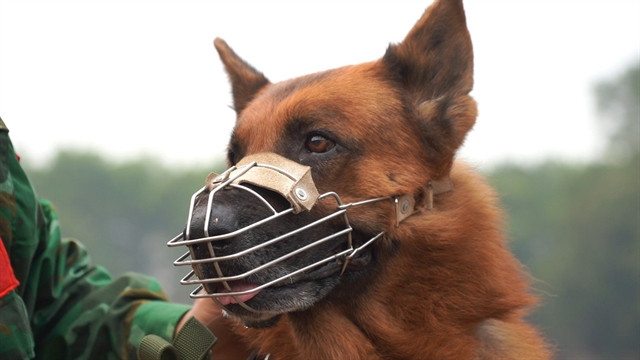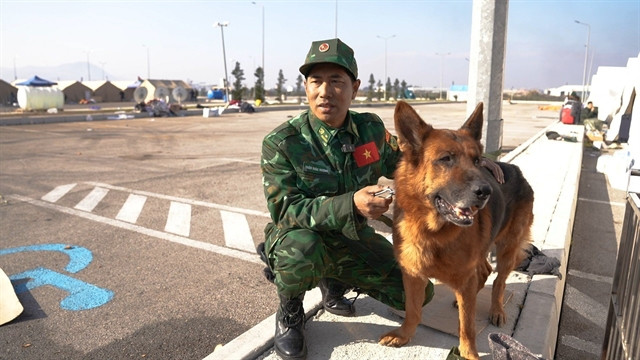 |
| Military working dogs are trained in the field. VNA/VNS Photos |
Military dogs are more than just an effective weapon for border guard soldiers.
These working dogs are loyal and reliable fellow warriors that stand shoulder to shoulder with their human counterparts to carry out search and rescue missions every time they are deployed.
In a mission to assist with humanitarian aid and disaster relief efforts following the earthquake in Turkey, the military working dogs helped 76 soldiers of the Vietnamese Border Guard successfully complete their search and rescue mission.
Over six days, from February 14 to February 19, the soldiers and their six dogs achieved remarkable results by identifying 31 locations with signs of life, 15 more positions with deceased and recovering 38 victims amidst the rubble in Antakya City, Hatay Province in southern Turkey.
The highly skilled and experienced working dogs are from Border Guard Vocational School No 24 under the command of the Border Guard Command. The six dogs, named Ê Py, Javo, Pokka, Or Tơ, Vat, and Tôm Pa, are a vital part of the Vietnamese Border Guard and the People's Army of Vietnam who joined the mission.
Having gone through a rigorous selection process, the six military working dogs participated in many search and rescue missions in Việt Nam, such as the rescue of the Rào Trăng-Thừa Thiên Huế hydroelectric power plant, the collapse of the quarry at the Bản Vẽ Tương Dương hydroelectric power plant in central Nghệ An Province, landslides in Quảng Trị, Phấn Mễ coal mine waste landslide in northern Thái Nguyên Province, and the landslide in northern Hòa Bình Province.
 |
| Military dogs are trained in specialised fields to become combat dogs, drug detection dogs, explosive detection dogs, search and rescue dogs, and scent-tracking dogs. |
The dogs, selected from two breeds of German Shepherd and Malinois, had found numerous bodies buried under the ground.
Major Nguyễn Quang Thuyên, Principal of Border Guard Vocational School No 24, said that training dogs to safeguard national sovereignty and border security, combat crime, protect important economic targets, and search and rescue operations are the school's primary tasks.
Originating from two specialised fields of combat dog training and guard dog training for target protection, the school has developed into five specialised fields of training, including combat dogs, drug detection dogs, explosive detection dogs, search and rescue dogs, and scent tracking dogs.
By the end of 2022, the school conducted 102 training courses, training nearly 3,000 service dogs.
“Scent tracking dogs are a particularly important tool for reconnaissance forces to determine the direction of investigation in criminal cases," Thuyên said. "Finding the source of a suspect's scent amidst multiple scent sources through the initial scent sampling is the basis for reconnaissance forces to identify the perpetrator and complete the assigned mission quickly."
Strict selection process
Regarding the selection process of dogs for training, Major Nguyễn Văn Nghĩa, Head of the school’s Search and Rescue Dog Training Department said that the selected dogs all originate from German Shepherd and Belgian Malinois breeds.
The school mainly imports the parents of the dogs and then breeds them on-site.
 |
| Dogs are selected based on strict criteria to become military working dogs. |
When the dogs are born, they are selected based on criteria such as good appearance, no congenital defects, good barking, and agility in movements. When the dogs are raised until they are about three to four months old, the trainer starts introducing them to the leash, muzzle, and name according to their code number, he said.
From 10 to 12 months old, each dog continues to undergo at least a year of training. After that, the school will establish a dog selection board to officially train the dog in each field of expertise depending on their ability, appearance, and temperament.
"To select dogs for special expertise such as source detection and search and rescue, the school focuses on finding active and playful dogs, those who like to pick up objects or show signs of sniffing," Nghĩa said. "Dogs with strong nerves, agility, and a tendency to bite or bark will be trained to become combat dogs. Each dog will only learn one speciality until he finishes the course."
According to Major Nguyễn Viết Linh, the long-term training process creates a close connection between working dogs and trainers, increasing effectiveness in combat and task performance.
"The training of working dogs has difficulties due to the characteristics of animals, which are not as easy to absorb as human training," he said. "A working dog requires time to get acquainted, pamper, and train from simple to complicated rules to form habits gradually.”
“For Ep, after five years of training, this dog can now understand my unique signals. In the field, I don't need to give verbal commands. I raise my hand, and Ep will automatically search for positions and bark when he finds positions that need to be checked."
Pairs of comrades
For trainers, these working dogs are loyal comrades and are treated as valuable and respected assets.
Lieutenant Colonel Nguyễn Văn Hưởng, a search and rescue officer of Border Guard Vocational School No 24 and his partner Pokka were among the best pair of comrades in the rescue mission in Turkey.
The pair discovered three locations of victims, pulled out one body and handled two other positions of victims to local units on the first day of the rescue mission on February 14.
 |
| A military working dog and his trainer during the search and rescue mission in Antakya City in Hatay Province in southern Turkey. |
This was the first time Lieutenant Colonel Nguyen Van Huong and his dog Pokka carried out an international mission together.
“In addition to essential items for soldiers, we also prepared cold-resistant clothes, gloves, and food such as canned meat and dry dog food for our soldiers of four legs," he said. "The military dog handlers guided the dogs to practise in harsh conditions such as mountainous terrain in early mornings to prepare well for the search and rescue process."
Despite careful preparation and training, Hưởng said accidents sometimes happened.
"On the third day of the mission, after returning from the site with sharp iron bars, I noticed blood stains on the ground and Pokka's abnormal gestures," he said. "After checking, the team found Pokka had a deep cut from glass in his leg. He had a deep wound and was bleeding heavily. The medical staff and I performed a blood transfusion, cleaned and bandaged the wound, applied medicine to Pokka."
Another dog named Ê Py, the partner of Captain Nguyễn Việt Linh, was also injured while on duty in Turkey. The dogs were treated with many favourite foods such as sausages, beef, ham, quail eggs and quickly returned to the site to continue the mission after one day.
"Ê Py loves to eat," Linh said. "Although there is food in the bowl, he will jump up and demand the new dish when he sees new food in the trainer's hands."
Regarding the effectiveness of the work, Pokka is considered the most enthusiastic and energetic ‘soldier’ in the team. Pokka was trained at the age of four. He is always sharp and ready to take on the mission no matter how complex and challenging tasks are.
In daily life, Pokka still behaves like a child, especially when Hưởng is away on long missions.
"Every time I come back from long trips, Pokka jumps on me, scratching and pretending to bite me," he said. "I usually buy a dozen of eggs to 'compensate' Pokka.” – VNS